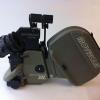Leaderboard
Popular Content
Showing content with the highest reputation on 01/20/2014 in all areas
-

RED cameras absent from all Oscar cinematography and best picture nominees
nahua and one other reacted to Sean Cunningham for a topic
Oh, and it didn't click until now, I must be getting old, Gravity is this year's Life of Pi test. More than 80% of that film is not Alexa or film it's synthetic, lit by digital artists using the Arnold renderer (same as Pacific Rim and, going back a bit, Monster House). Cuaron named his Framestore vfx supervisor, Tim Webber, in his acceptance speech at the Golden Globes which makes him a class act, unlike that prick Ang Lee. Cuaron acknowledged that his film could not have been made otherwise. If they give the DP award to Lubezki I'm fairly positive he will also be showing Claudio how it's done. Unlike Miranda, Lubezki was actually involved in the visual effects and animation that make up an overwhelming majority of the film's imagery and therefore rightfully shares ownership in the end result, like Deakins does in his immersive forays into effects and animation.2 points -
RED cameras absent from all Oscar cinematography and best picture nominees
Ernesto Mantaras and one other reacted to Dano312 for a topic
I imagine that you have to think of any big production as part of a very well established camera ecosystem. The camera, lens, whether you use film or video etc can not be isolated choices. Arri, which has been around since the silent era, very purposely made the Alexa so that it can be interchanged with (film-based) Arricams almost without notice - all the bits of gear that make it work (gears, flags, matte boxes) are widely availabe and second nature to a practised camera crew. You can find crews around the world that will know how to work such standard 35mm-like gear. While RED has made tremendous progress, its layout, unique setup, and the depth of support by rental houses are just not as well established. While very technically adept directors like Fincher and Jackson might prefer a RED and enjoy fidling with it and pushing the camera system to its limits, most directors have enough on their hands and want as little drama as possible from the camera dept.2 points -

BM 4k vs GH4 4K Comparison
Axel reacted to Ben Prater for a topic
Most digital film shot today is on the Alexa. The Alexa is not shooting 4k, it shoots sub-2k. ML on 5D3 is freaking amazing. Properly upscale your 5D3 to 4k and I promise you -- nobody will ever be able to tell you were shooting HD or 4k. No, the 5D3 is not obsolete. I suspect it'll be an important camera body for budget filmmakers for years to come.1 point -
for 4k…has the 5d mark 3 become obsolete?1 point
-
I liked the camera too…but now I want to shoot 4k…so what happens to my 5d mark 3 raw and bmpcc (pocket camera)..? for 4k are these cameras obsolete now???1 point
-

RED cameras absent from all Oscar cinematography and best picture nominees
Aussie Ash reacted to Rob Bannister for a topic
none of it is really 4K, 2K upres mostly and HD. Elysium was 4K and then upres to 8K for Imax. Only a handful of studios here in the city can even handle 4K. We have renders for TV that tke 8hrs a frame to render in HD. SO take a shot that is 30F to 300 frames long...and usually if its 300 frames long its some epic explosion with tons of pieces.....put 4K and STUPID STEREO into the mix and then 48 or 60FPS. its getting ridiculous. I prefer 2K 2.39:1 with some nice film grain to it for texture with a great story any day.1 point -

RED cameras absent from all Oscar cinematography and best picture nominees
Aussie Ash reacted to Sean Cunningham for a topic
It's not yet common. Some directors insist and have enough juice to pressure production to fork over the substantial budget increase both 4K VFX and DI will cost them. Prior to the phenomenon of IMAX presentation for non-educational films 4K was more common for anamorphic films where that's considered rather minimal quality for anamorphic. I would be really surprised if more than 10% of big VFX films are being posted at 4K and certainly less than 20% right now. That's up from hearing about the one or two films a year requiring 4K post just a few years ago. The shift to DCP already gave a resolution boost to 2K finish over general release print quality, commonly considered worth about 1K thanks to all the optical steps. If you've ever seen first-gen prints straight off a neg projected big and beautiful you cry at how much is just gone by the time it hits the multiplex. This is a big reason why the death of film as an acquisition format is far too premature, regardless of how good any digital camera is, because DCP of analog origination is the best looking digital presentation going. Similarly, digital origination looks nice® when printed to film and optically projected. It would be interesting to see experiments with digital origination, print to neg and then scan that negative for DI and eventual DCP. Anyhow, yes, I was surprised to read someone had busted out the VV. They must be doing pan/zoom or perhaps some tricky projections where the extra resolution is desirable above working from a 4K 4-perf scan. It's maybe a little overkill if they're using it for an Alexa section. CG itself, regardless of standard practice, doesn't need to be rendered to your target, working resolution because we tyipically work at 4x to 8x oversampling. You have further shading and geometric oversampling if you're using a REYES style micro-polygon renderer (Pixar's Renderman implementation, prman, or SESI's Mantra renderer being the most common) where, nominally, if you were to only do a 1x spatial sample you would still have four micro quads shading beneath each pixel. Straight raytracers commonly have even more oversampling thrown at them as they're prone to spatial aliasing but there's decades of research into techniques like poisson disc sampling and other stochastic techniques striving to improve results while lowering computation because noise is less distracting and more aesthetically pleasing (and more consistent with motion picture imagery either analog or digital) than hard, jagged lines.1 point -
RED cameras absent from all Oscar cinematography and best picture nominees
ike007 reacted to Rolf Silber for a topic
Even when shooting with the ARRI "The Fridge" D 20 back in the "old days" the decision to use it instead of a RED was a decision for the aesthetic character of the image, it's "film-likeness", that made people to put up with a camera which was kind of hard to handle concerning size and weight. This concept - stay as near to film aesthetics as possible - was quite efficiently transferred to the Alexa which provides great DR plus excellent colour rendition, especially skin tones. Also Alexa fitted better into the existing workflows. A decisive bit less franken-rigging. Very nice and not overly complicated menues. Sturdy body. And great reliabilty. What befuddles me is that the rental costs of a camera should be a big factor in a major production of a narrative film or even an average one. For a German TV-Movie costs for camera (excluding lenses) is maybe 3% of the budget or even a bit less. The cost-factor should be really only kicking in, when you go small to low budget or your production manager is named Scrooge. Apart from questions of aesthetics - you like or dislike a certain characteristic delivered by a sensor (which really is there or maybe only assumed :-)) - again workflow on set and in post is also cost-wise the decisive factor to take this or that camera. Not rental costs. In the end all a camera is is a tool. And Alexa seems to fit in better under most circumstances for middle to bigger budget productions of narrative films. No miracle here and definitely no "fanboy'ism".1 point -

First look - Olympus OM-D E-M1 vs Panasonic GH3
Re-up Flms reacted to Michael Ma for a topic
I don't own the Olympus but after seeing some footage, it looks like the stabilization gets lost sometimes and has to readjust itself, which would make that part of footage unusable. But when it's working well, which is most of the times, it looks amazing Handheld video while walking is a challenge on the GH3. I've been playing with 720p@60p 72Mbit/sec, so warp stabilizer (on Premiere Pro CC) has crisper edges to work with, then converting that to 24p (frame blend in export only) with some descent results if you don't mind mixing 720p footage into your 1080p footage.1 point -
It doesn't really matter that much which brand or model mic or other gear you'll get, because in the beginning the more important question you should be concern with is how, not which brand. Don't fall into severe GAS, and don't go into hyper spending mode right in the beginning. You really don't need all that much to get started. Røde, Sennheiser, or even Azden will all do, but instead of obsessing about particular brand shotguns or other type mics to go for, make sure you get a separate audio recorder, and preferably a stereo mic for that, like the Røde Stereo Videomic Pro, for example, along with dead cats for the mics. Even though the GH3 has adjustable audio levels, don't rely on the in-camera audio alone. Use it only for reference audio and possible b-roll sound, but always make sure you'll get a proper soundscape for the final edit. If you plan on selling your film to the riders, make sure you get the sounds of the bikes recorded properly. Also pay attention to getting the ambient sounds in each location. For that you'll need the separate audio recorder and optimally placed mic. It doesn't matter if the sounds aren't always 100% real time sounds, they'll love your film if you get the sounds of the bike appear 'larger than life' in your film. You'll get away with less than ideal footage, as long as the soundtrack sounds good. A little bit of Hollywood-esque magic isn't bad for documentaries, either. After all, bikes like classic Triumphs with 360-degree crankshafts make an awesome sound even without any outrageous aftermarket pipes, so do some classic v-twins and120-degree crankshaft inline triples, and even the classic Harley sound is pretty entertaining. So it really pays off to put some effort into getting those sweet engine sounds on a separate soundtrack which you can then use to beef up the final edit. The weight is on the quality of the sound, not the loudness of it. Just don't go for wrong soundtrack for the wrong bike, though, they'll pick it up and hate you for it, even though it's pretty common in Hollywood movies. Nevermind those Japanese inline fours, they all sound the same and they're all equally boring. Speaking of following the bikes, if you plan on riding and shooting pillion, you'd better consider getting a GoPro or Sony action cam which you can attach to yourself. Forget about the sound when riding, although you can try capturing something behind your back, but chances are you'll catch just a lot of wind noise and rumble. But if you can catch a decent soundtrack of the engine, maybe with the lavalier taped behind your back, by all means try it. So all in all, apart from the GH3 and a (wide enough angle) lens, the essential gear to go for in the beginning would be a decent monopod or at least a tripod, an ND filter, (or at least a polariser), a shotgun mic, a separate audio recorder, and perhaps a separate mic and a light stand/tripod for it, and of course furry covers for all the mics. You could also invest a little bit in a basic lavalier mic, too, but not much point in going overboard with that right in the beginning. I don't think it is one of the most urgent items in your shopping list. Practise with some cheaper one first, or go for a shotgun mike, and buy at least one external audio recorder, like the Zoom H1, for example, which costs less than 100€. Good luck with the project. Shouldn't be a boring one.1 point
-

Why I am going with 4K and why you should too
odie reacted to Andrew Reid for a topic
It's like some people have skim read the article. I'm clear that any image quality is camera dependant. Taken in a general sense if you are going to get 4x the data off the sensor and onto the card, you will gain a lot of other attributes if the camera's image processor and codec are up to scratch. For DSLRs to move away from line skipping and binning to a 4K video signal from the sensor, that avoids one of the ways so much dynamic range is lost in the first place, the throwing away of lots of pixel data.1 point

